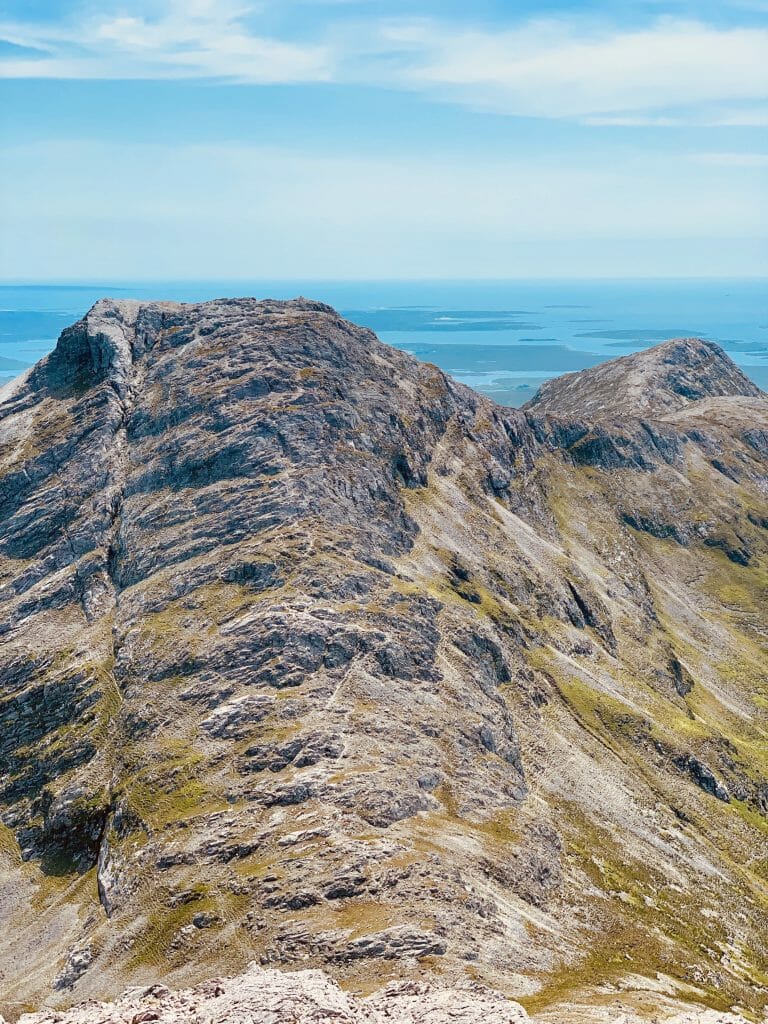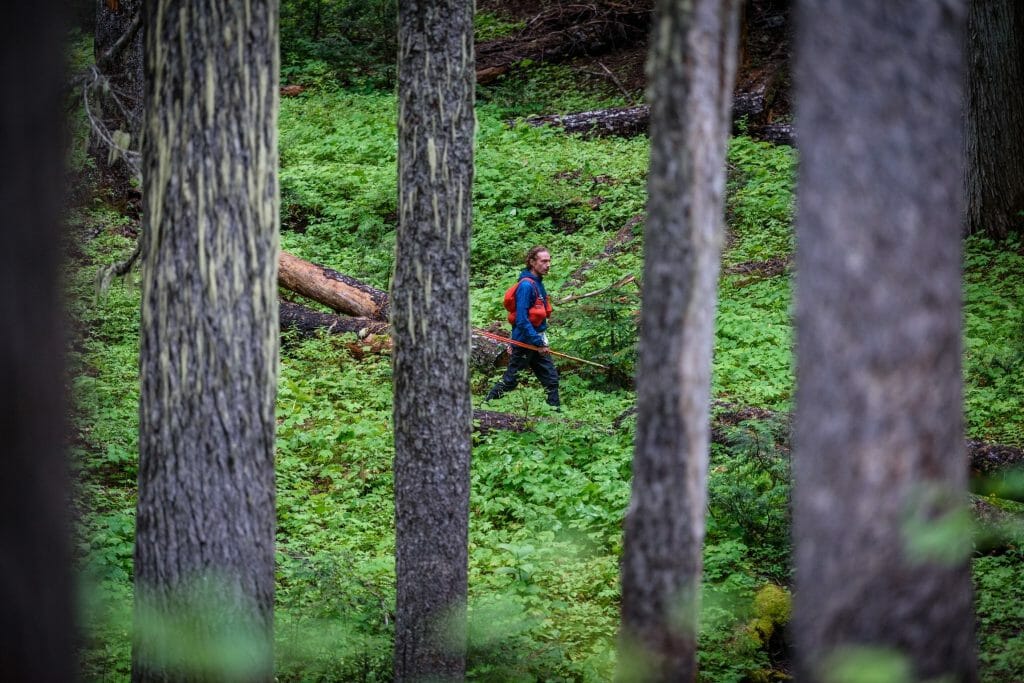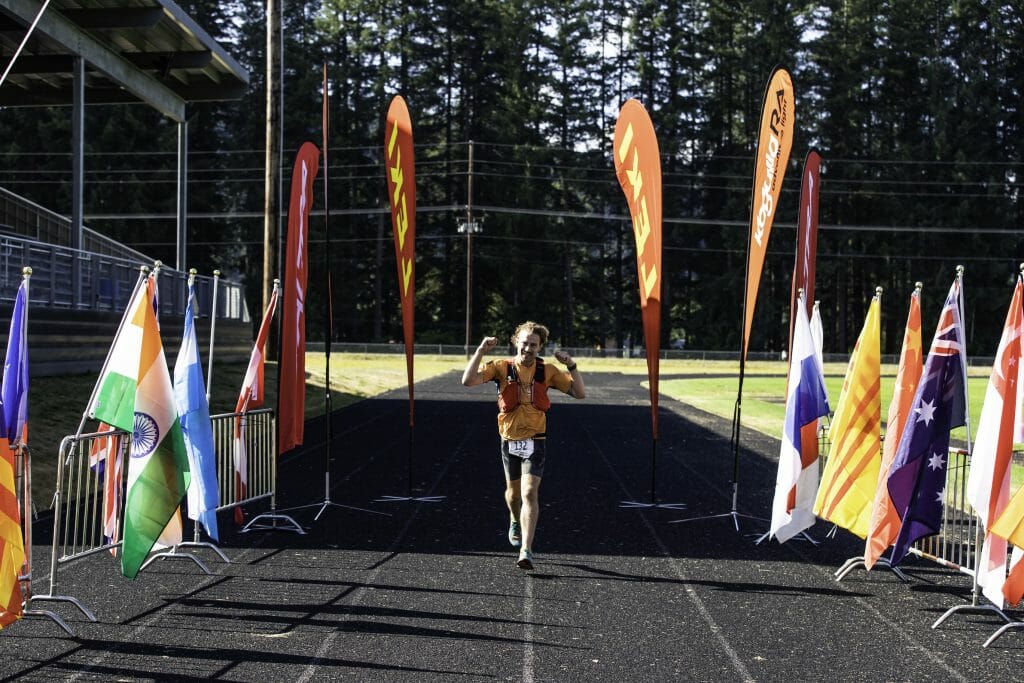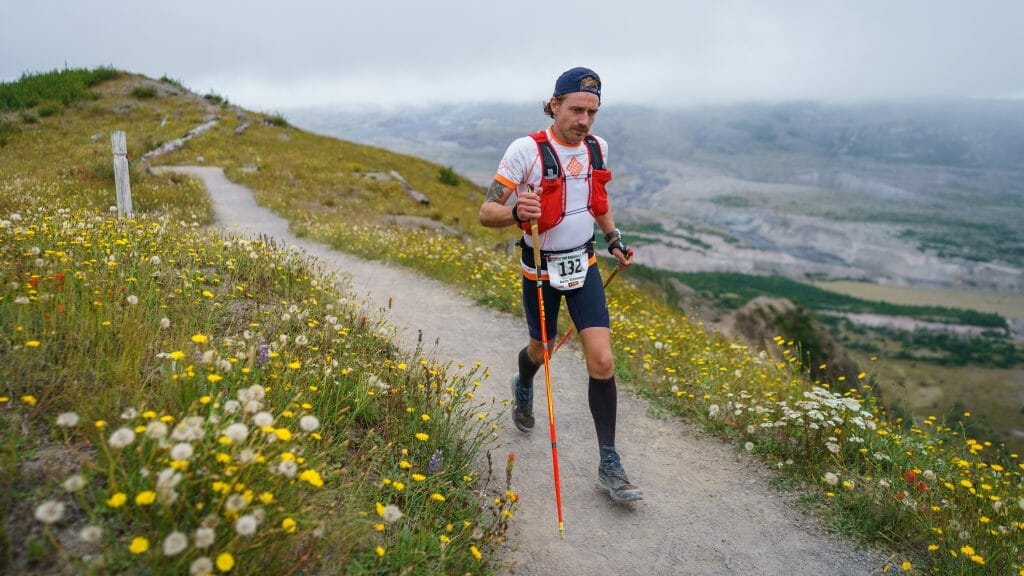It blends together a wee bit, the three days. I remember damp, dark forests, a sense of always being closed in. After I put my wet weather gear on the first evening, I took it off only once or twice between then and Monday morning. It rained all three nights, and when it wasn’t raining, I was engulfed in low clouds and mist. Even the few moments it dried out, I kept my jacket on to shield myself from the mosquitoes—mosquitoes trying to bite me through my raincoat, mosquitoes the size of a normal fly.
I hadn’t anticipated these conditions, but I loved them. The course was so remote, so unlike home. It felt like a real adventure.
* * *
Having spent the previous couple of years training for and attempting what’s meant to be the hardest 100-mile mountain race in the world, Andorra’s Ronda dels Cims, I wanted to try something different in 2019. I live in the north of Ireland, but I’m very familiar with the American ultra scene. I had heard of Candice Burt and her Triple Crown of 200-milers—Bigfoot, Moab, and Tahoe. There was something about the Bigfoot 200, a point-to-point in southern Washington, that appealed to me. I’d never been to the Pacific Northwest, hadn’t visited the Cascade Mountains. Here was an opportunity to go deep into a new region.
I got into mountain running by way of fell running, where the emphasis is on navigation and self-reliance. I still identify first and foremost as a fell runner, so I was drawn to this long, wild route that would play off those skills.
Looking at the course and the elevation profile for Bigfoot, I thought I could run it in about 65 hours. I’d get to change clothes a couple of times, maybe sleep for a bit. Even though the longest I’d ever run was 38 hours, it didn’t seem daunting. I was excited—purely excited. As I’d learned in previous races, the greater the distance, the better I seem to do.
The winter of 2018 to 2019, I trained with a road marathon coach for the first time. Seeing good results, I decided to find a mountain-specific coach for Bigfoot—my first time doing that for an ultra. I started working with an Uphill Athlete coach three months before the race. With a season of speedwork behind me, we shifted the focus to volume.
The meat of the training block she programmed involved three peak weeks spaced out from the end of June to the end of July. Each one totaled around 30 hours of work (including strength). The highlight of the first of those weeks was a 60-kilometer out-and-back across the Maamturk Mountains in the west of Ireland, capped off with another 12 hours over the next two days. Two weeks later, I set an FKT on the Mourne 500s, a local fell running round. My self-designed 62.5-kilometer route took me to all 39 summits over 500 meters in the Mourne Mountains. (Billy Reed’s record of 13:10 had stood since 2011; I set a new best of 12:38.)

Day two of the Galway training block: the spectacular Glencoaghan Horseshoe
The final week before my three-week taper, I did 20 hours in two days, with the goal of making it as specific to the race experience as possible. After a 7-hour run on a Saturday afternoon, I had a sleep in the car, then did another several hours in the mountains by head torch. The next morning, I got up and ran some more. During a 200-mile race, you’re always going to be tired and you’re always going to have to run; those 20 hours helped prepare me mentally and physically for getting up and moving again while tired.
* * *
I arrived in Randle, Washington, the location of the race finish, on Wednesday, August 7—the same day I left Belfast. After checking into my motel, I went for a short run to shake the travel out of my legs.
The race started at 9 a.m. that Friday. Feeling properly rested and ready, I positioned myself near the front. I didn’t have a crew, and I wouldn’t have any pacers. It was just me and four drop bags—bags I had packed carefully but that weren’t guaranteed to hold exactly what I would want or need when I’d reach them. That was one of the more stressful aspects of race prep: Have I put the right things in the bag? It would have been easier if I’d just bought four of everything.
I sat in fifth place on the initial climb into the Mount St. Helens blast zone, and I stayed there through to my first drop bag at the Coldwater Lake aid station at 75 kilometers (46.5 miles). I grabbed what I needed for the night—or at least thought I did—and moved on.
The section from Coldwater Lake to Norway Pass stays high at around 1,500 meters (5,000 feet). It includes an out-and-back to the 1,760-meter (5,780-foot) high point of the race, Mount Margaret. I ran it with a guy named Adam.
Night brought thunderstorms, lightning, and heavy rain. As soon as Adam and I cleared the trees, the thunder rumbles broke into bolts of lightning that flashed horizontally across the sky. The rain intensified, turning the trails into streams. We were later told it was the worst storm to hit the area in 50 years.
The key piece of kit I’d forgotten to lift from my Coldwater drop bag was my waterproof gloves.
By the time I got to the Norway Pass sleep station and my second drop bag, I was extremely cold. Even after changing into dry clothes, I knew it was going to take some time to warm up. I told Adam to keep going. Then I got into one of the tents and slept for almost 3 hours—much longer than I thought I would so early in the race.
I headed back into the rain around 3 a.m., now in 14th place. Feeling good and moving well after the stop, I caught and passed several runners over the next 6 hours, bringing myself back into the top 10.

Heading out of the Klickitat aid station Sunday afternoon.
You don’t ever think about these ultras in terms of the total distance. You break them down into whatever mental chunks you can cope with best. So instead of wondering how long it would take me to go 40 miles, I focused on averaging 5 kilometers (3 miles) each hour. If I missed that goal one hour, I’d make up for it the next hour. In that way I maintained a consistent pace right to the finish.
I reached my third drop bag late Saturday afternoon, at the Lewis River sleep station at 180.5 kilometers (112.1 miles). From there I would navigate the 20-mile section to Council Bluff. I got myself set for the night—grabbed my head torch and backup battery and stowed them where they would be easy to reach—and left around 4 p.m. As I’d been warned, this stretch ended up being one of the most challenging of the race. It weaved its way across creek after creek. There was so much up-along-down-across that it felt like I was splashing through the same creek a dozen times and getting nowhere.
When the sun set around 8 p.m., I switched on my head torch. It should have lasted 8 hours. Thirty minutes in, it blinked three times to signal it was on emergency power. I had two of these batteries to do me for the night, plus a backup head torch that was super small. I swapped out the battery, and almost immediately after putting the new one in, the same thing happened. When the head torch died 30 minutes later, I was forced to switch to my backup. It was not designed for use in a dark forest.
The theme across the whole race was that you had to use a GPS to navigate. The flagging was very sparse at times. In this particular section, I had my GPS out a lot. Between the poor light from my backup head torch and my frequent stops to consult my GPS, I slowed way down. Instead of taking me 6 hours, the section took about 9 hours. I ran out of food. I tried not to think about cougars.
Then an hour out from Council Bluff, the first woman, Sofi, and her pacer passed me. Her pacer saved me by giving me his backup head torch. Cold, depleted, cramping badly, I finally made it to the remote aid station. This wasn’t my next drop bag location. This wasn’t a sleep station. It was a place where you could get food, refuel, sit down for a while. The moment I realized it wasn’t outfitted for sleeping, I was heartbroken. It was pouring and I desperately needed to get my body temperature back up.
I huddled under two blankets in the aid tent and tried to sleep but couldn’t stay dry. The aid station captain, Brian, looked after me really well. He insisted I move to his SUV, where I dried my clothes, ate some food, and slept a little more. With nowhere to go, I couldn’t DNF. The only way to finish this was to warm up and get moving again. So that’s what I did.
It was approaching dawn when I left the aid station on Sunday morning. Even though I had stopped for so long, I had lost only a couple of positions. I was still within the top 10. Like the previous day, I had a great run. I felt strong and fast. It was amazing to be over 50 hours into an event and still be running well.
But with all the sleep I’d gotten, I wasn’t going to be able to bridge the hours between me and the top five guys. Instead, I decided to manage my position. I would keep a 2-hour buffer between me and the next runner.
* * *
By Monday morning I was looking forward to pizza and cold beer. I’d eaten about 20 grilled-cheese-and-pickle quesadillas throughout the race (a classic Irish combination with an American twist). As delicious as they were, I was ready for a different form of melted cheese. But standing between me and these rewards was a half marathon on pavement. I had managed a few niggles up to that point, nothing major. The instant I hit that flat road, the tendons along the front of each shin swelled up and reduced me to an awkward run/walk.
My form improved as I neared the high school in Randle. I was able to click off the lap of the track at a nice pace and cross the finish line running. I’d covered Bigfoot’s 206.5 miles in 72:45:28, good for eighth place. It was almost 10 a.m. and the sun was finally out.

Coming in to the finish.
In the afterglow of finishing, I didn’t dwell on what had gone wrong (the forgotten gloves, the head torch malfunction, the unplanned sleeps). The reality of the 200-mile distance is that there is plenty of time for things to go sideways. I’d been working toward this goal for months. I believed I could do it, but it wasn’t until I did that I felt a true sense of accomplishment.
Then my hunger took over. I had two pizzas and was told a third wasn’t possible—there were other runners to feed. I hung around the finish line for most of the day, eating and sipping beer and watching racers trickle in. I was in the top 10 of what would be 105 finishers. It’s an unbelievable test of endurance for the race organizers and volunteers. As exhausted as they may have been, they were all super friendly, bending over backward to help us runners. I’ll never forget the warm, welcoming vibe of each aid station, and the race as a whole.
The ultrarunning community in America, especially the 200-mile niche of it, reminds me of the fell running community at home—close-knit, supportive, and a little wild. Very few people want to run in the mountains for three full days. I loved being out there for longer, hours ahead of and hours behind runners who feel the same way.
-by Uphill Athlete Aaron Shimmons, @irunovermountains
Further Reading
Tips to Aid Recovery
Ultrarunning Training in your 60’s
Tapering for a Race or Event: What to do and what NOT to do.
The Use of Blood Lactate Measurements in Ultrarunning Training

